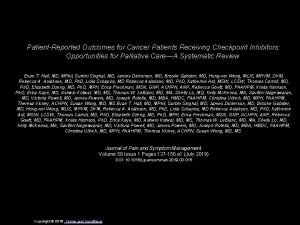Patient Reported Outcomes Measurement Information Systems PROMIS Domains

- Slides: 1

Patient Reported Outcomes Measurement Information Systems (PROMIS) Domains Explain A Large Proportion Of The Variance Of Quality Of Life In Patients With Advanced Chronic Kidney Disease O. Ekundayo, N. Edwards, A. Bansal, A. Ali, E. Tang, A. Xu, P. Thiagalingam, M. Novak, I. Mucsi. 1 Division of Nephrology and the Kidney Transplant Program, Toronto General Hospital, University Health Network, University of Toronto Background: Results • Quality of life is a complex construct influenced by sociodemographic, clinical and psycho-social factors 1. • Patient reported outcome measures (PROMs) assess the illness experience from the patient’s perspective. 2 • The Patient Reported Outcomes Measurement Information System (PROMIS) project has developed generalizable and universal PROMs. 3 • Little has been done to assess the relative contribution of PROM variables to explaining health related quality of life in advanced chronic kidney disease (CKD) Table 1: Baseline Characteristics of Participants PROMIS Instruments • These generic tools developed by the NIH can be used to measure domains of health status/Quality of Life (QOL) across disease groups and in the general population. • T score metric: mean = 50, SD = 10; normed to the U. S. general population. These scales have been validated in samples obtained from general population and some chronic medical diseases • We have validated PROMIS instruments in kidney transplant patients in our centre; validation among patients on dialysis is almost complete. EQ-5 D-5 L • This instrument, developed by the Euro. Qo. L group is a universal tool adapted to the population of each country. It comprises of 2 distinct self-report elements providing 3 principal approaches to analysis • The EQ-5 D profile: The patient’s self-reported health on the dimensions of the descriptive system and the EQ-VAS: patient’s global rating of their overall health, between 0 and 100. Both self report elements can be focus of analysis, as well as • The EQ-5 D index, a single number that reflects the state of health referenced for the general population of that country. It is the preferred method of Qo. L measurement in adults for economic analysis Hypothesis • PROMIS scores explain a significant part of the quality of life of patients with Advanced Chronic Kidney Disease, over and above that which is explained by socio-demographic factors Methods Convenience Sample of patients followed up in the Outpatient Clinics Inclusion Criteria: • 18 years or older; • Advanced CKD (e. GFR<20 ml/min/1. 76 m 2) • On Dialysis or Renal Transplant Exclusion Criteria: • Unable to understand read at least Grade 5 English (necessary for questionnaire completion); • Unwilling or unable to provide informed consent. Patients with Advanced CKD (492) Eligible Patients (471) 21 not on RRT 125 Declined Enrolled (346) Characteristic Dialysis patients (n = 125) 65 + 15 Age ( mean + SD ) Sex Male 66 (56%) Female 52 (44%) Marital Status Single 22 (19%) Married / Common Law 48 (41%) Divorced/Separated/Wi 47 (40%) dowed Education Level Less than 12 years 98 (85%) 12 or more years 17 (15%) Ethnicity White 50 (42%) Asian 10 (8%) Black 51 (43%) Other 7 (6%) Albumin g/L (mean + SD) 37 + 5 Ever Been Immigrant No 38 (29%) Yes 81 (71%) Income Category Less than $30, 000 45 (64%) $30, 000 - $70, 000 14 (20%) Greater than $70, 000 11 (16%) Charlson Comorbidity Score Less than 3 24 (22%) 3 or Greater 86 (78%) Diabetic No 51 (46%) Yes 60 (54%) Hemoglobin (mg/L) 108 + 12 Transplant patients (n = 221) 52 + 16 123 (57%) 91 (43%) Figure 1: EQ-5 D-5 L Mean Health Score Distribution Total Cohort (n = 346) 56 + 17 Figure 6: Correlation differences between Models with and Without PROMIS Domains P value < 0. 001 0. 786 189 (57%) 143 (43%) < 0. 001 48 (23%) 130 (62%) 32 (15%) 70 (21%) 178 (54%) 79 (24%) Figure 2: PROMIS (Depression) Score Distribution Discussion 0. 002 141 (69%) 62 (31%) 239 (75%) 75 (25%) <0. 001 122 (57%) 45 (21%) 21 (10%) 26 (12%) 42 + 3 172 (52%) 55 (16%) 72 (22%) 33 (10%) 40 + 6 121 (63%) 70 (37%) 154 (51%) 151 (49%) < 0. 001 Figure 3: PROMIS (Sleep) Score Distribution < 0. 001 31 (19%) 59 (37%) 71 (44%) References 76 (33%) 73 (32%) 82 (35%) < 0. 001 100 (51%) 97 (49%) 124 (40%) 183 (60%) < 0. 001 144 (73%) 53 (27%) 128 + 16 195 (63%) 113 (37%) 120 + 17 Figure 4: PROMIS (Physical Function) Score Distribution R-squared 0. 09 0. 19 Interquartile Range 0. 08 – 0. 09 0. 18 – 0. 19 III 0. 51 – 0. 52 IV V 0. 63 0. 65 0. 62 – 0. 63 0. 64 – 0. 66 Raw Scores Model 1 Model 2 Model 3 Model 4 Model 5 Raw Scores 1. 00 0. 37 0. 45 0. 73 0. 80 0. 83 Model I: Age, Gender, Ethnicity, Marital Status, Income, Education, Diabetes. Model II: Model I + Charlson Comorbidity Index, Renal Replacement Modality, Albumin and Hemoglobin. Model III: Model II + PROMIS Physical Function Score. Model IV: Model III + PROMIS Pain Score. Model V: Model IV+ PROMIS Depression, Fatigue & Sleep Scores. 1. Murtagh FE, Addington-Hall J, Higginson IJ. The prevalence of symptoms in end-stage renal disease: a systematic review. Adv Chronic Kidney Dis. 2007; 14(1): 82 -99. 2. Weldring T, Smith SMS. Patient-Reported Outcomes (PROs) and Patient -Reported Outcome Measures (PROMs). Health Services Insights. 2013; 6: 61 -68. doi: 10. 4137/HSI. S 11093. 3. Cella D, Riley W, Stone A, Rothrock N, Reeve B, Yount S, et al. The Patient-Reported Outcomes Measurement Information System (PROMIS) developed and tested its first wave of adult self-reported health outcome item banks: 2005 -2008. J Clin Epidemiol. 2010; 63(11): 1179 -94 < 0. 001 Table 2: Multivariable Linear Regression Table 3: Correlation Coefficient Model showing progressive changes in the between the Raw scores and R-squared values (measure of variance) Predicted Values of each Model I II • Sociodemographic and clinical factors explained 19% of the variance of the quality of life score. • When PROMIS scores are added, variance predicted increased to 65%, accounting for 45% difference in variance. • PROMIS instruments include information, which are important aspects of quality of life and not captured by other tools. • Assessing the PROMIS scores in routine clinical practise will ensure that more accurate assessment of quality of life is made. • Further studies needed to assess the effect of PROMIS Scales in predicting improvement in quality of life over time on Renal Replacement Therapy Figure 5: PROMIS (Physical Function) Score Distribution 4. PROMIS-57 Profile v 2. 1. [cited 2018 19 Mar 2018]. Available from: http: //www. healthmeasures. net/index. php? option=com_instruments &view=measure&id=860&Itemid=992 5. Herdman M, Gudex C, Lloyd A, Janssen M, Kind P, Parkin D, Bonsel G, Badia X. Development and preliminary testing of the new five-level version of EQ-5 D (EQ-5 D-5 L) Qual Life Res 2011 Dec; 20(10): 1727 -1736 Disclosure There are no relevant financial disclosures or conflicts of interest in relation to this presentation

